Are you ready to enhance your website’s visibility and climb the search engine rankings? Look no further! At LerriHost, we’re excited to share our insider tips on mastering on-page SEO. This powerful technique is the key to unlocking your site’s full capacity and attracting more organic traffic.
On-page SEO is the cornerstone of any successful search engine optimisation strategy. By fine-tuning your website’s content and structure, you can significantly improve your chances of appearing in top search results. Whether you’re a seasoned pro or just starting out, our detailed guide will help you navigate the ever-changing landscape of SEO.
Get ready to dive into the world of keyword research, content optimisation, and technical tweaks that will make search engines fall in love with your site. With LerriHost by your side, you’ll soon be crafting web pages that not only rank well but also provide real value to your visitors.
Key Takeaways
- On-page SEO is critical for improving search engine rankings
- Effective optimisation can significantly boost website visibility
- Keyword research is the foundation of successful on-page SEO
- Content quality and structure play a vital role in optimisation
- Technical aspects like page speed and mobile-friendliness are essential
- LerriHost offers expert guidance on implementing on-page SEO strategies
Understanding the Fundamentals of On-Page SEO
On-page SEO basics are essential for a successful online presence. These elements work together to enhance your website’s visibility in search results. This attracts more customers to your business.
The Importance of On-Page SEO
On-page SEO is vital for website success. It aids search engines in understanding your content, making it easier for users to find your site. By optimising your site with effective on-page SEO, you can boost your rankings and drive more targeted traffic.
Essential SEO Components
Several key SEO components are vital for effective on-page optimisation:
- High-quality, relevant content
- Proper use of header tags
- Optimised meta titles and descriptions
- Internal linking structure
- Image optimisation with alt text
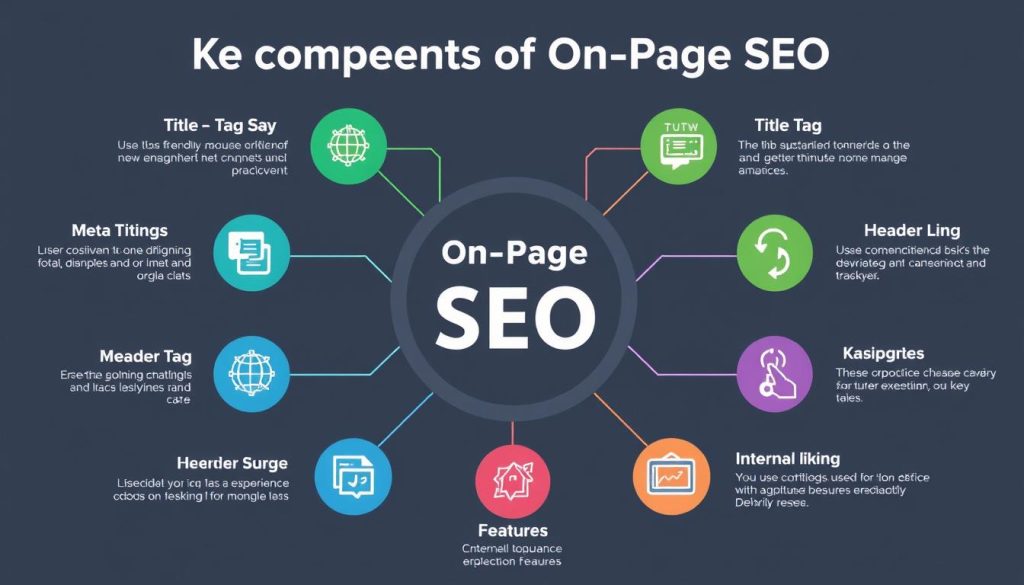
Search Engine Algorithms Evolution
Search engine algorithms have undergone significant changes over the years. They now focus on user experience, content quality, and relevance. Understanding these changes is key to adapting your SEO strategy and staying competitive.
| Algorithm Update | Year | Focus |
|---|---|---|
| Panda | 2011 | Content quality |
| Penguin | 2012 | Link quality |
| Hummingbird | 2013 | Semantic search |
| RankBrain | 2015 | Machine learning |
By mastering on-page SEO fundamentals and keeping up with algorithm changes, you can lay a solid foundation for your website’s success in search rankings.
Mastering Keyword Research and Implementation
Effective keyword research is the cornerstone of successful SEO strategies. It’s about finding and using the right keywords to boost your website’s visibility in search engine results.
Finding High-Value Keywords
Begin by brainstorming topics relevant to your business. Utilise tools like Google Keyword Planner or SEMrush to uncover related terms with high search volumes and manageable competition. Opt for long-tail keywords that align with your niche and target audience.
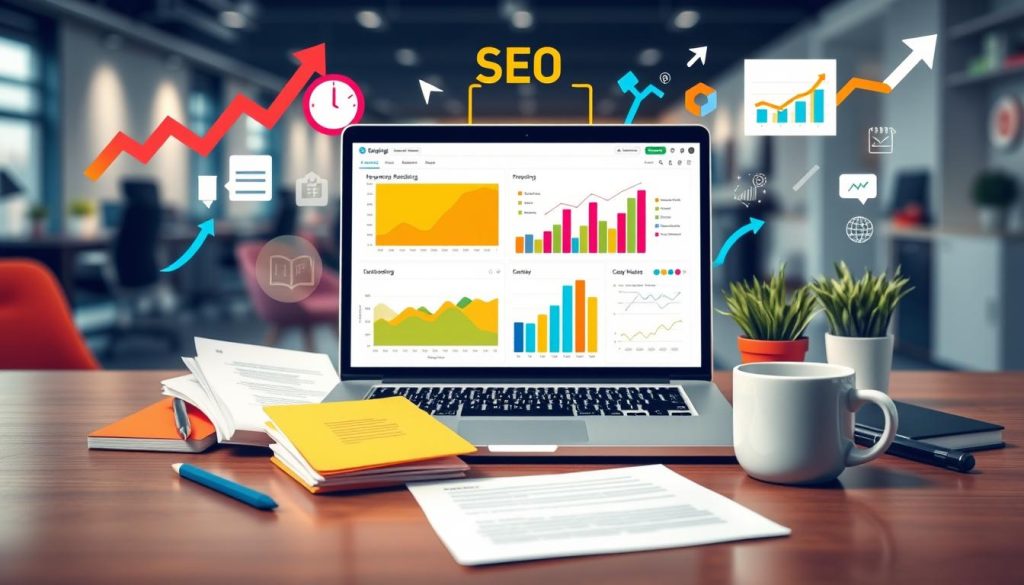
Understanding Search Intent
Search intent is key in keyword selection. It’s about understanding what users seek when they enter a query. Are they looking to purchase, learn, or find a specific website? Tailor your content to meet these needs for enhanced rankings and user satisfaction.
Strategic Keyword Placement
After identifying valuable keywords, strategically place them throughout your content. Include them in title tags, meta descriptions, headers, and naturally within your text. Avoid keyword stuffing, which can harm your SEO. Focus on creating valuable, readable content that incorporates keywords organically.
| Keyword Placement Area | Importance |
|---|---|
| Title Tag | High |
| Meta Description | Medium |
| Headers (H1, H2, H3) | High |
| Body Content | Medium |
| Image Alt Text | Low |
By excelling in these keyword research and implementation aspects, you’ll significantly enhance your website’s SEO performance. This will attract more qualified traffic to your site.
Optimising Title Tags and Meta Descriptions
Title tags and meta descriptions are key to on-page SEO. They affect your site’s search engine rankings and click-through rates from SERPs.

Creating compelling title tags is critical for SERP optimisation. Ensure they are under 60 characters to appear fully in search results. Place your primary keyword at the start and ensure it mirrors the page’s content.
Meta descriptions, though not a direct ranking factor, are essential for click-through rates. Craft concise, engaging descriptions within 155-160 characters. They should summarise your page content and include a call-to-action.
| Element | Best Practices | Impact on SEO |
|---|---|---|
| Title Tags | Use primary keyword, keep under 60 characters, be descriptive | Direct ranking factor, improves click-through rates |
| Meta Descriptions | Include keywords naturally, 155-160 characters, add call-to-action | Influences click-through rates, indirectly affects rankings |
Always create unique title tags and meta descriptions for each page. This helps search engines better understand your content and avoids duplicate content issues. By excelling in these areas, you’ll enhance your website’s visibility and draw more targeted traffic.
Crafting SEO-Friendly URLs and Site Structure
Building a strong foundation for your website is vital for SEO success. This means creating SEO-friendly URLs and designing an effective site structure. These components are key to better user experience and search engine crawlability.
URL Structure Best Practices
SEO-friendly URLs are vital for both users and search engines. They should be brief, descriptive, and include relevant keywords. Here are some essential guidelines:
- Use hyphens to separate words
- Keep URLs short and meaningful
- Include target keywords where appropriate
- Avoid unnecessary parameters or numbers
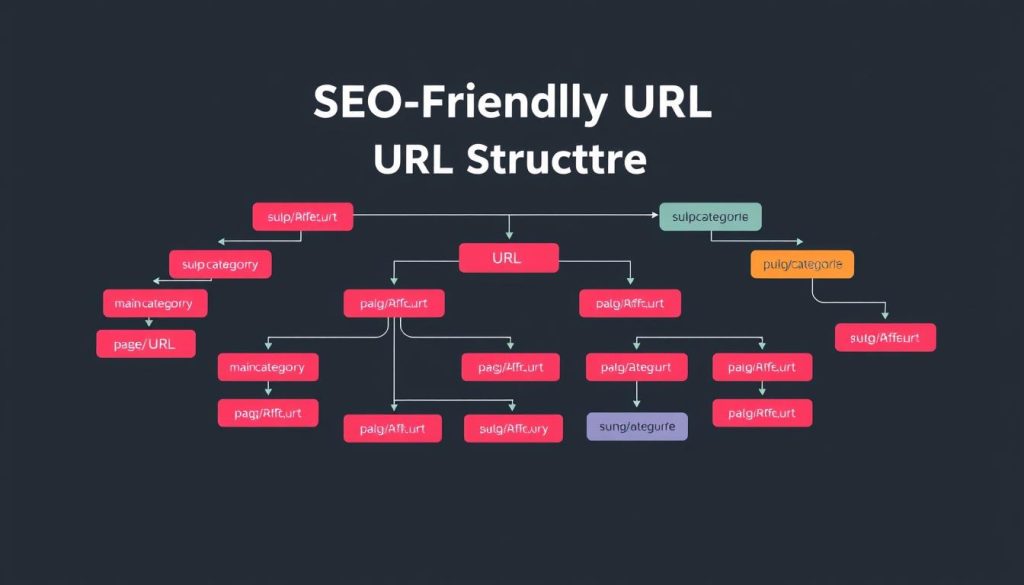
Site Architecture Planning
A well-thought-out website architecture aids search engines in understanding your content’s hierarchy. It also enhances user navigation. Consider these aspects when designing your site structure:
| Factor | Importance | Implementation |
|---|---|---|
| Logical hierarchy | High | Organise content into categories and subcategories |
| Flat structure | Medium | Limit URL depth to 3-4 levels from homepage |
| Internal linking | High | Link related pages to distribute link equity |
| Navigation menus | High | Create clear, intuitive menus for easy access |
By following these best practices for SEO-friendly URLs and site structure, you’ll lay a solid groundwork for your website’s search engine performance and user experience.
Content Optimisation Strategies That Drive Results

Creating engaging content is key to successful SEO writing. To enhance your search rankings and engage your audience, effective content optimisation strategies are essential. Let’s dive into some proven tactics that can boost your online presence and deliver significant results.
Quality is the cornerstone of content optimisation. Aim to produce valuable, informative content that meets your readers’ needs and answers their questions. By creating in-depth, well-researched content, you’ll not only satisfy search engines but also gain your audience’s trust.
SEO writing goes beyond keywords; it’s about understanding and fulfilling search intent. Analyse what your target audience is searching for and tailor your content to meet those needs. This ensures your content remains relevant and useful.
Enhance user experience by incorporating multimedia elements. Images, videos, and infographics can make your content more engaging and shareable. This increases its chances of attracting backlinks and social media attention.
| Strategy | Benefits | Implementation Tips |
|---|---|---|
| Featured Snippet Optimisation | Increased visibility, higher click-through rates | Use concise, structured answers to common queries |
| Long-form Content | Better search rankings, increased time on page | Create detailed guides or in-depth articles |
| Updated Content | Improved relevance, sustained traffic | Regularly update existing content with new information |
Remember, successful content optimisation is a continuous journey. Continuously monitor your performance, gather feedback, and refine your strategies to stay ahead in the ever-evolving digital landscape.
Header Tags and Their Impact on SEO
Header tags are vital for on-page SEO and content organisation. They guide search engines through your content’s hierarchy and offer a clear path for readers. We’ll look into how to use header tags wisely and insert keywords within them for superior SEO outcomes.
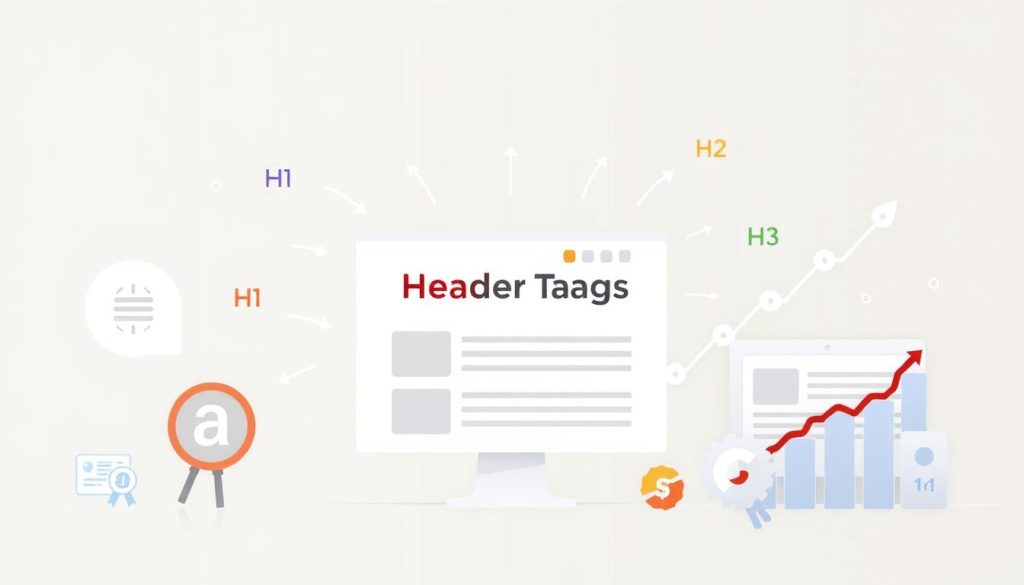
Proper H1-H6 Tag Usage
Correctly applying header tags is key for SEO and user experience. The H1 tag should appear only once per page, usually as the main title. H2 tags are perfect for main sections, and H3-H6 tags suit subsections and smaller parts of your content.
| Tag | Usage | SEO Impact |
|---|---|---|
| H1 | Main page title | High |
| H2 | Main sections | Moderate |
| H3-H6 | Subsections | Low to Medium |
Keyword Distribution in Headers
Adding keywords to your header tags can significantly enhance your SEO. Place your main keyword in the H1 tag and sprinkle related keywords in the following headers. This approach clarifies your content’s focus to search engines, boosting your ranking for relevant searches.
- Use your primary keyword in the H1 tag
- Include related keywords in H2 and H3 tags
- Ensure headers are descriptive and relevant to the content
Optimising your header tags and keyword distribution can refine your content structure and boost on-page SEO. Always aim for natural, user-friendly headers while embedding relevant keywords for optimal results.
Image Optimisation and Alt Text Best Practices
Visual content is vital for improving user experience and boosting search rankings. Understanding image SEO techniques can greatly enhance your website’s performance. Let’s dive into some essential strategies for optimising visual content.
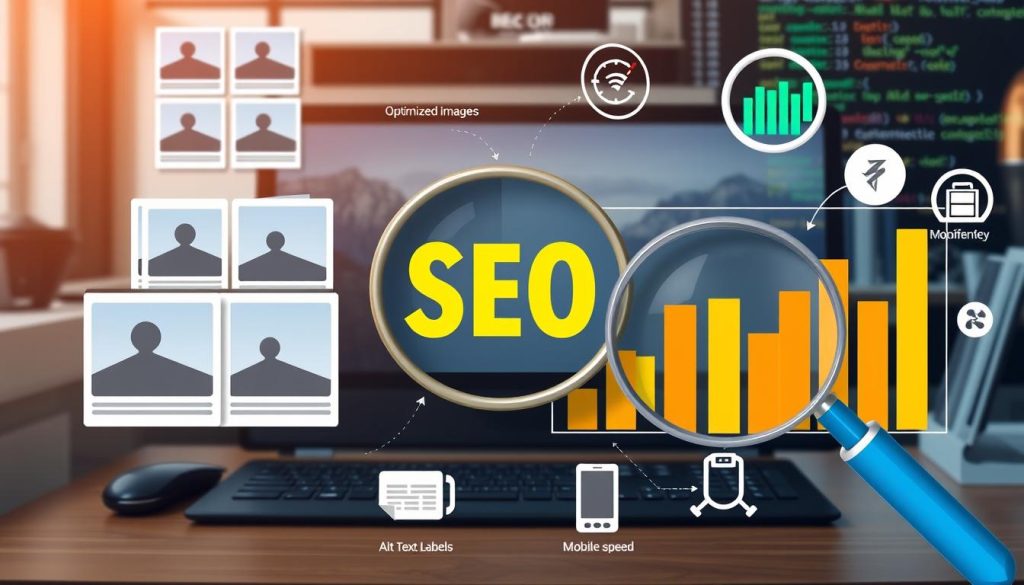
Reducing file size is key for image SEO. Compress your images to maintain quality while speeding up page load times. Use descriptive, keyword-rich file names to help search engines understand your visuals better.
Alt text is a critical component of image optimisation. It provides a text alternative for visuals, boosting accessibility and search rankings. Craft concise, descriptive alt text that naturally includes relevant keywords.
Remember, alt text should accurately describe the image content while incorporating target keywords where appropriate.
Here are some best practices for effective alt text:
- Keep it brief and informative
- Include relevant keywords
- Avoid keyword stuffing
- Describe the image accurately
By implementing these image SEO techniques, you’ll not only enhance your website’s visual appeal. You’ll also improve search performance and user experience.
| Image Optimisation Technique | SEO Benefit | User Experience Benefit |
|---|---|---|
| File size reduction | Improved page load speed | Faster browsing experience |
| Descriptive file names | Better image context for search engines | Improved image search results |
| Alt text optimisation | Additional ranking opportunities | Enhanced accessibility |
Internal Linking Strategy for Better SEO Performance
A well-crafted internal linking strategy is vital for boosting your website’s SEO performance. It connects related pages, guiding visitors and helping search engines grasp your content structure.
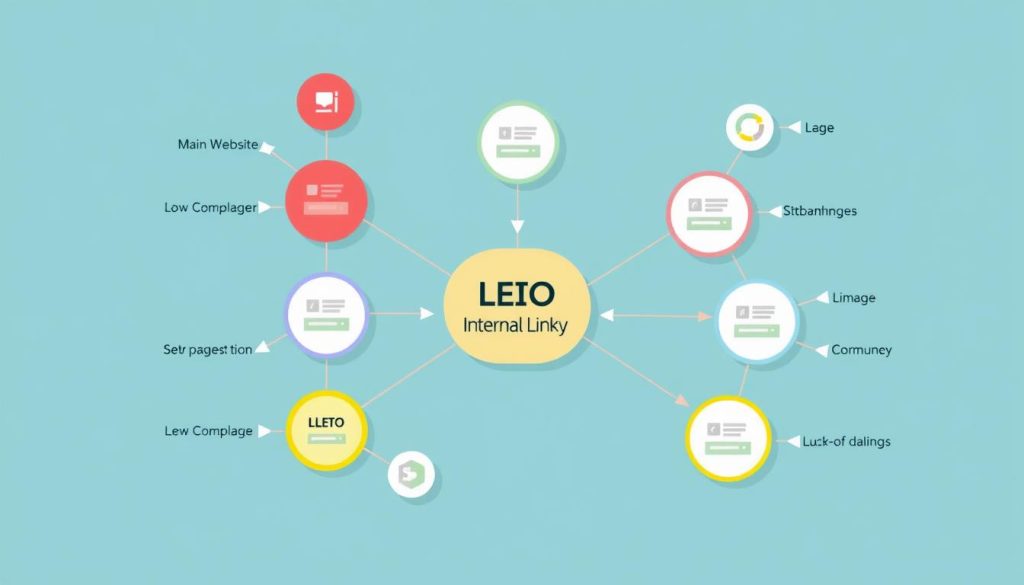
Natural Link Placement
It’s essential to place internal links naturally within your content. Avoid forcing links where they don’t fit. Instead, seek opportunities to link to relevant pages that enhance your readers’ experience. This strategy improves user engagement and keeps visitors on your site longer.
Anchor Text Optimisation
Optimising anchor text is critical for effective internal linking. Use descriptive, keyword-rich phrases that accurately reflect the linked page’s content. This clarity helps both search engines and users understand the link’s purpose.
| Poor Anchor Text | Optimised Anchor Text |
|---|---|
| Click here | Learn about on-page SEO techniques |
| Read more | Discover advanced keyword research methods |
| This page | Explore our extensive SEO guide |
Site Navigation Enhancement
Enhancing site navigation through strategic internal linking boosts both SEO and user experience. Create a logical page hierarchy, use breadcrumbs, and include relevant links in your main navigation menu. This structure aids search engines in crawling your site efficiently and allows users to find information swiftly.
By adopting these internal linking strategies, you’ll develop a more cohesive website structure. This benefits both search engines and your visitors.
Mobile Optimisation: A Critical On-Page SEO Factor
In today’s digital world, mobile SEO is essential for a successful online presence. The rise in smartphone use has led search engines to focus on mobile-first indexing. This makes mobile optimisation a top priority for websites.

Responsive design is central to mobile optimisation. It ensures your website adjusts well to different screen sizes, providing a great viewing experience on any device. This not only boosts user satisfaction but also helps improve your site’s search engine rankings.
To excel in mobile SEO, consider these key factors:
- Fast loading times
- Easy navigation
- Readable content without zooming
- Touch-friendly buttons and links
Google’s mobile-first indexing means your mobile site is now the main factor in determining rankings. This change highlights the need to ensure your mobile site has all the key content and SEO elements found on the desktop version.
| Mobile SEO Element | Impact on User Experience | Impact on SEO |
|---|---|---|
| Responsive Design | Improved readability and navigation | Higher rankings in mobile search results |
| Fast Loading Speed | Reduced bounce rates | Better crawling and indexing |
| Mobile-friendly Content | Increased engagement | Improved relevance signals |
By focusing on mobile optimisation, you’re not just boosting your search engine rankings. You’re also giving mobile users a better experience. This can lead to more traffic, higher engagement, and better conversion rates for your website.
Page Loading Speed and Performance Metrics
In today’s fast-paced digital world, page speed is critical for both user experience and search engine rankings. Websites that load quickly keep visitors engaged. They are more likely to rank higher in search results.
Speed Optimisation Techniques
To enhance page speed, consider these optimisation techniques:
- Compress images and use modern formats like WebP
- Minify CSS, JavaScript, and HTML
- Leverage browser caching
- Use a content delivery network (CDN)
- Optimise server response time
LerriHost offers hosting solutions that can significantly boost your website’s performance. This ensures faster load times and improved user satisfaction.
Core Web Vitals Understanding
Core Web Vitals are specific factors Google considers important for a webpage’s user experience. They include:
| Metric | Description | Good Score |
|---|---|---|
| Largest Contentful Paint (LCP) | Loading performance | 2.5 seconds or faster |
| First Input Delay (FID) | Interactivity | 100 milliseconds or less |
| Cumulative Layout Shift (CLS) | Visual stability | 0.1 or less |
By focusing on these Core Web Vitals, you can enhance your website’s performance optimisation. Tools like Google PageSpeed Insights can help you measure and improve these metrics.
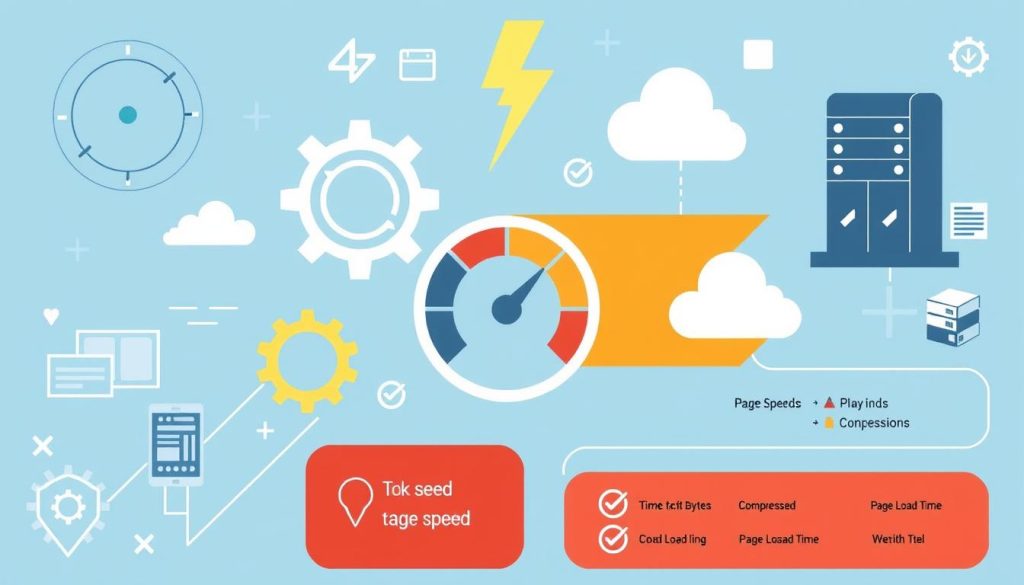
Remember, improving page speed and Core Web Vitals not only boosts your SEO efforts. It also creates a better user experience. This leads to increased engagement and conversions.
Schema Markup Implementation Guide
Enhance your website’s search engine visibility with schema markup. This tool helps search engines grasp your content better. It leads to rich snippets that catch the eye in search engine results pages (SERPs).
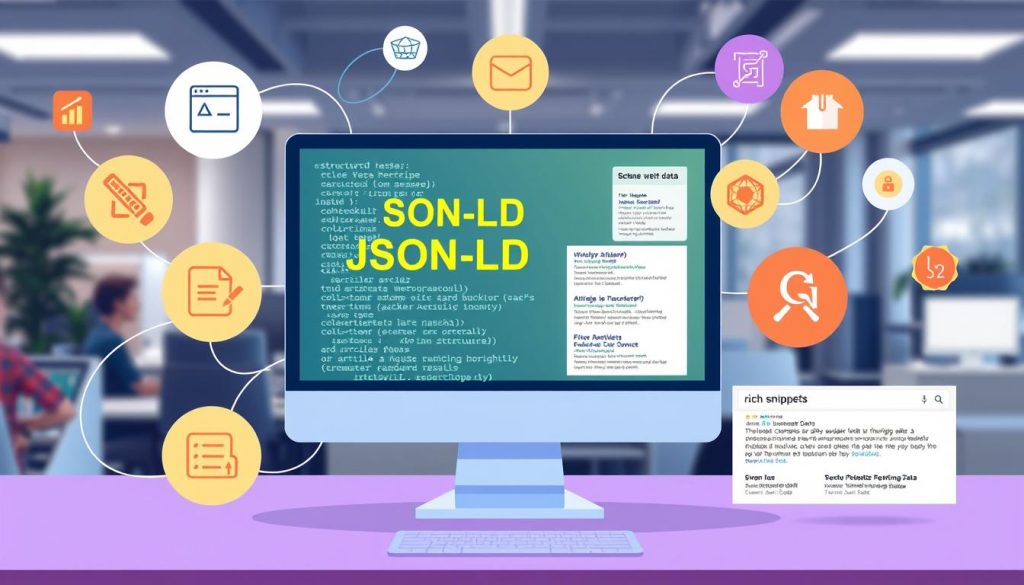
Schema markup adds context to your web pages through structured data. By using it, you signal to search engines what your content is about. This can boost your site’s visibility and click-through rates.
Now, let’s look at some common schema markup types:
- Organisation schema: Highlights business information
- Product schema: Showcases product details and reviews
- Recipe schema: Displays cooking time, ingredients, and ratings
- Event schema: Presents event dates, locations, and ticket info
Adding schema markup might seem complex, but it’s actually simple. You can employ Google’s Structured Data Markup Helper or JSON-LD format. After adding it, check your markup with Google’s Rich Results Test.
| Schema Type | Benefits | Example Rich Snippet |
|---|---|---|
| Product | Displays price, availability, ratings | Star ratings, price |
| Recipe | Shows cooking time, calories, ratings | Image, prep time, rating |
| Event | Presents date, time, location | Date, venue, ticket info |
Schema markup isn’t a direct ranking factor. Yet, it can greatly enhance your site’s visibility in search results. Begin with your most critical pages. Then, expand your schema implementation across your site gradually.
Content Quality and Readability Factors
Creating top-notch content is essential for SEO success. High-quality, readable content keeps visitors engaged, encouraging them to stay longer. This positive user experience signals search engines that your website offers value, potentially boosting your rankings.
Readability Score Improvement
To enhance your content’s readability, focus on these key areas:
- Use short sentences and paragraphs
- Choose simple words over complex ones
- Break up text with subheadings and bullet points
- Utilise active voice for clarity
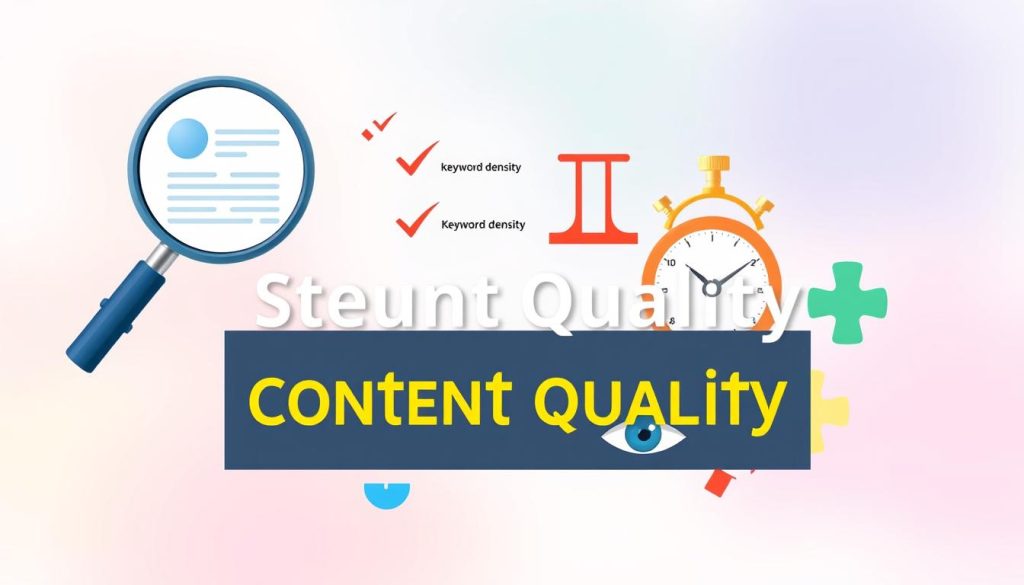
Tools like Hemingway Editor or Yoast SEO can help you assess and improve your content’s readability score. Aim for a score that matches your target audience’s reading level to maximise user engagement.
Content Structure Guidelines
A well-structured piece of content aids both readability and SEO. Follow these guidelines:
- Start with a clear introduction
- Use logical headings and subheadings
- Include relevant keywords naturally throughout the text
- End with a concise conclusion or call-to-action
Remember, quality content that’s easy to read and navigate will keep visitors on your site longer, reducing bounce rates and potentially improving your search engine rankings. By focusing on content quality, readability, and user engagement, you’ll create a win-win situation for both your audience and search engines.
Social Media Meta Tags and Sharing Optimisation
Social media SEO is vital for boosting your online presence. Optimising content for social sharing increases visibility and drives traffic. Implementing Open Graph tags is a key part of this process.
Open Graph tags control how your content appears on social platforms. They let you customise the title, description, and image in social media posts. This makes your content more appealing and clickable.

- Create compelling titles and descriptions that entice users to click
- Use high-quality, relevant images that grab attention
- Include your brand name in the title for increased recognition
- Keep descriptions concise and informative
By implementing these strategies, you can significantly improve your content’s performance on social platforms. This leads to increased engagement and website traffic.
| Open Graph Tag | Purpose | Example |
|---|---|---|
| og:title | Defines the title of your content | <meta property=”og:title” content=”Your Title Here”> |
| og:description | Provides a brief summary of your content | <meta property=”og:description” content=”Your description here”> |
| og:image | Specifies the image to display | <meta property=”og:image” content=”https://yourimage.jpg”> |
By focusing on social media SEO and using effective Open Graph tags, you can enhance your content’s visibility. This encourages more social sharing, driving more traffic to your website.
Local SEO On-Page Elements
Local SEO is vital for businesses to reach out to customers nearby. Optimising on-page elements boosts your visibility in local search results. This attracts more foot traffic to your shop.

Local Business Schema
Using local business schema is a strong strategy to improve your website’s search result appearance. It provides search engines with your business’s details, like address, phone number, and opening hours. Adding this markup increases your visibility in rich snippets and local knowledge panels.
Geographic Keyword Integration
Integrating geographic keywords into your content is key for local SEO. Include your city, neighbourhood, or region in titles, headings, and meta descriptions. This helps search engines link your business to specific locations, boosting your local search visibility.
| On-Page Element | Example |
|---|---|
| Title Tag | Best Coffee Shop in Manchester | Java Junction |
| Meta Description | Visit Java Junction, Manchester’s favourite coffee shop. Enjoy freshly roasted beans and homemade pastries in the heart of the city centre. |
| H1 Heading | Welcome to Java Junction: Manchester’s Premier Coffee Destination |
| Content | Our Manchester cafe sources the finest beans from local roasters… |
By concentrating on these local SEO on-page elements, you can greatly enhance your business’s local search visibility. This will attract more customers from your target area.
Common On-Page SEO Mistakes to Avoid
Steering clear of SEO errors is vital for website success. We’ll look at common optimisation mistakes and best practices to boost your site’s performance.

Many website owners make SEO blunders without realising it. These mistakes can harm their search rankings. Here’s a list of common pitfalls:
- Neglecting keyword research
- Overusing keywords (keyword stuffing)
- Ignoring meta descriptions
- Creating duplicate content
- Overlooking mobile optimisation
To sidestep these SEO errors, follow these best practices:
- Conduct thorough keyword research
- Use keywords naturally in your content
- Write unique, compelling meta descriptions
- Create original content for each page
- Ensure your site is mobile-friendly
By tackling these common mistakes, you can greatly enhance your website’s search engine visibility. Remember, SEO is a continuous effort. Regularly review and update your on-page elements to stay competitive.
| SEO Mistake | Impact | Solution |
|---|---|---|
| Slow page load speed | High bounce rates, poor user experience | Optimise images, minify CSS and JavaScript |
| Broken links | Negative user experience, wasted crawl budget | Regularly audit and fix broken links |
| Poor internal linking | Difficulty in site navigation, reduced page authority | Implement a logical internal linking strategy |
By avoiding these common SEO errors and following best practices, you’ll be well on your way to bettering your website’s search engine rankings and overall performance.
Measuring On-Page SEO Success with Analytics
Tracking and measuring your SEO efforts is vital for success. SEO analytics offer insights into your website’s performance. They help you make informed decisions for optimisation.
Key Performance Indicators
To gauge your on-page SEO success, focus on these essential KPIs:
- Organic traffic
- Keyword rankings
- Bounce rate
- Time on page
- Conversion rate
Regularly tracking these metrics helps you spot areas for improvement. It also measures the success of your optimisation efforts.
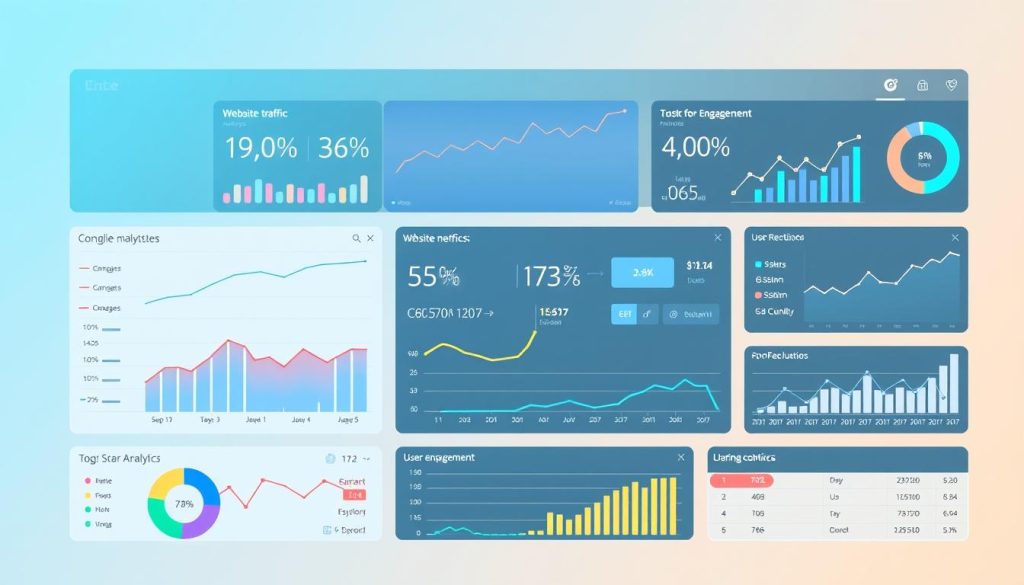
Tracking Tools and Methods
Utilise these powerful tools for thorough SEO analytics:
| Tool | Key Features | Best For |
|---|---|---|
| Google Analytics | Traffic analysis, user behaviour | Overall website performance |
| Google Search Console | Keyword rankings, indexing issues | Search engine visibility |
| SEMrush | Competitor analysis, keyword research | Comprehensive SEO strategy |
Embrace these tools to gather valuable data for your optimisation strategy. By consistently analysing your SEO analytics, you can refine your approach. This will help you achieve better search engine rankings.
Conclusion
Mastering on-page SEO is vital for online success. By applying the strategies from this article, you’ll enhance your website’s visibility and draw more organic traffic. An effective on-page SEO strategy involves a complete approach. This includes keyword optimisation, content quality, and technical aspects.
As search engines evolve, continuous improvement in SEO is key. Stay updated with algorithm changes and industry trends to stay ahead. Regularly analysing and refining your on-page elements will improve your search rankings over time.
Remember, your web hosting’s role in SEO success cannot be overlooked. A reliable host like LerriHost provides the necessary stability for your optimisation efforts. Fast loading times and robust infrastructure ensure a user-friendly experience, which search engines favour.
It’s time to apply your knowledge of on-page SEO techniques. Start today, and see your website’s search rankings improve. This will bring you closer to achieving your digital goals.
